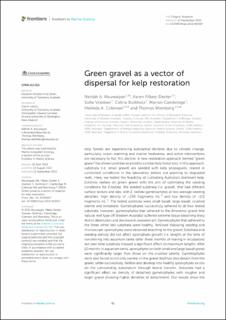| dc.description.abstract | Kelp forests are experiencing substantial declines due to climate change, particularly ocean warming and marine heatwaves, and active interventions are necessary to halt this decline. A new restoration approach termed “green gravel” has shown promise as a tool to combat kelp forest loss. In this approach, substrata (i.e. small gravel) are seeded with kelp propagules, reared in controlled conditions in the laboratory before out-planting to degraded reefs. Here, we tested the feasibility of cultivating Australia’s dominant kelp, Ecklonia radiata on green gravel with the aim of optimising the seeding conditions for E.radiata. We seeded substrata (i.e. gravel), that had different surface texture and size, with E. radiata gametophytes at two average seeding densities: high density of ~230 fragments mL-1 and low density of ~115 fragments mL-1. The tested substrata were small basalt, large basalt, crushed laterite and limestone. Gametophytes successfully adhered to all four tested substrata, however, gametophytes that adhered to the limestone gravel (the natural reef type off Western Australia) suffered extreme tissue bleaching likely due to dissolution and decrease in seawater pH. Gametophytes that adhered to the three other test substrata were healthy, fertilised following seeding and microscopic sporophytes were observed attaching to the gravel. Substrata and seeding density did not affect sporophyte growth (i.e. length) at the time of transferring into aquarium tanks (after three months of rearing in incubators) but over time substrata showed a significant effect on maximum lengths. After 12 months in aquarium tanks, sporophytes on both small and large basalt gravel were significantly larger than those on the crushed laterite. Gametophytes were also found to not only survive on the gravel itself but also detach from the gravel, settle successfully, fertilise and develop into healthy sporophytes ex situ on the surrounding substratum through lateral transfer. Substrata had a significant effect on density of detached gametophytes with rougher and larger gravel showing higher densities of detachment. Our results show the potential for green gravel to be a vector of dispersal for restoration in Western Australia where natural recovery of kelp forests has failed. | en_US |
